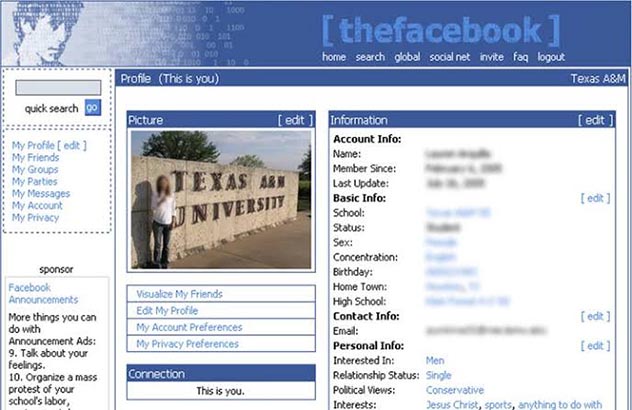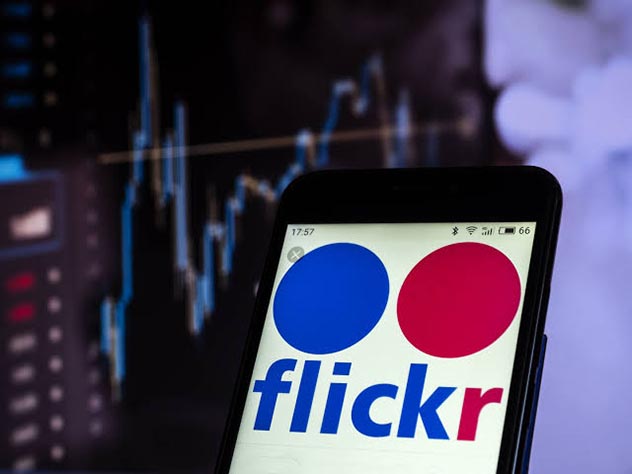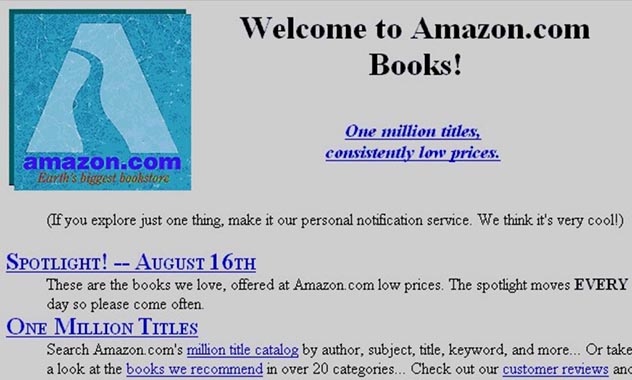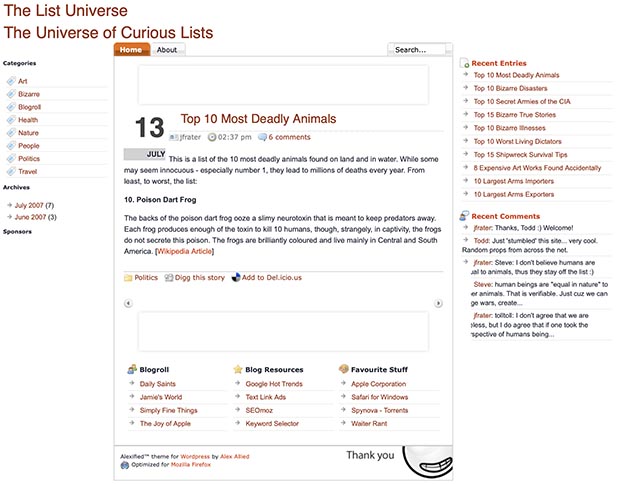 Mysteries
Mysteries  Mysteries
Mysteries  History
History 10 Surprising Stories About the Texas Rangers
 Humans
Humans 10 Philosophers Who Were Driven Mad by Their Own Theories
 Miscellaneous
Miscellaneous 10 Video-Game-Worthy Weapons and Armors from History
 Weird Stuff
Weird Stuff 10 Psychics Who Accurately Predicted Wartime Events
 The Arts
The Arts 10 Pieces of Art Inspired by a Broken Heart
 Health
Health 10 Science Fiction-Sounding New Medical Treatments
 History
History 10 Surprising Facts About the Father of Submarine Warfare
 Space
Space Ten Astonishing New Insights into Alien Worlds
 Weird Stuff
Weird Stuff 10 Bizarre Summer Solstice Rituals Still Practiced Today
 Mysteries
Mysteries Top 10 Haunting Facts About the Ghost Ship MV Alta
 History
History 10 Surprising Stories About the Texas Rangers
 Humans
Humans 10 Philosophers Who Were Driven Mad by Their Own Theories
Who's Behind Listverse?

Jamie Frater
Head Editor
Jamie founded Listverse due to an insatiable desire to share fascinating, obscure, and bizarre facts. He has been a guest speaker on numerous national radio and television stations and is a five time published author.
More About Us Miscellaneous
Miscellaneous 10 Video-Game-Worthy Weapons and Armors from History
 Weird Stuff
Weird Stuff 10 Psychics Who Accurately Predicted Wartime Events
 The Arts
The Arts 10 Pieces of Art Inspired by a Broken Heart
 Health
Health 10 Science Fiction-Sounding New Medical Treatments
 History
History 10 Surprising Facts About the Father of Submarine Warfare
 Space
Space Ten Astonishing New Insights into Alien Worlds
 Weird Stuff
Weird Stuff 10 Bizarre Summer Solstice Rituals Still Practiced Today
10 Crazy Origins Of Popular Websites
Most of our favorite websites and phone apps started off much differently than they appear today. If things had gone according to plan, you would be logging onto YouTube to find that date instead of Tinder or whatever app or website you currently use.
Want to plan a meet-up? You would think Instagram. Or, you just have a thing for comparing people’s photos? That would have been Facebook’s turf. How about if you wanted to know if the person you are about to call was available? You would use WhatsApp for that. The first version of WhatsApp did not even have instant messaging capability.
However, it appears that while the founders made their plans, fate often had other things in stock for them. Many founders watched as their initial plans flopped with only a small part of it becoming successful. Others like eBay, just watched them transform into some new products.
SEE ALSO: Top 10 Disturbing Facts About Facebook
10 YouTube Was A Dating Site
Today, YouTube is a hotbed of videos about almost anything. Curiously, it was intended as a platform to allow users meet prospective spouses at the time it launched in 2005. At the time, its founders, Jawed Karim, Steve Chen and Chad Hurley, wanted users to upload videos of them talking about what they wanted in a potential partner.
In keeping with their intentions, the founders used the slogan, “Tune in, Hook up” as the tagline of their website. No one uploaded any video though. Not even when the founders offered to give $20 to any woman who uploaded a video. The founders later decided to allow people upload videos about anything.
Jawed Karim, one of YouTube co-founders, broke the ice when he uploaded an 18-second video of himself at the zoo. As at the time of this writing, the video, titled “Me At The Zoo”, has over 79 million views with 3.8 million comments.[1]
9 Instagram Was Created For Meet-ups

Instagram was founded by Kevin Systrom and Mike Krieger in 2010. It was not the photo-sharing social media site, as we know it today. It was not even called Instagram. It was called Burbn—after bourbon whiskey.
The naming was deliberate. Systrom—who singlehandedly founded Burbn—loved bourbon whiskey and thought it was cool to name his product after it. Besides, the name was in keeping with its purpose. Burbn was built to plan meet-ups. Users could check in at any place they visited, make plans with friends to revisit the place in the future and later post photos of the meet-up.
Burbn soon flopped because it was just too complex to use. Meanwhile, Systrom noticed that users were often more interested in sharing photos of their meet-ups than in using the other features. He brought Mike Krieger on board and they both developed what would later become Instagram.
The duo planned Instagram as something in between Facebook and Hiptasmatic, which were the two top photo-sharing sites at the time. Hiptasmatic had good filters but terrible photo sharing capability. Facebook was the opposite. Instagram would have both.
Systrom did not forget the lesson he learned from the failure of Burbn either. He made sure Instagram was as simple as possible. To achieve this, they removed everything else from Burbn except the photo sharing, commenting and like tools. Now you know why Instagram has a clean and easy-to-use interface.[2]
8WhatsApp Was Supposed To Be A Phonebook With Attitude

WhatsApp founders, Jan Koum and Brian Acton did not know they had created a messaging app at the time they released the first version of WhatsApp in 2009. Two years earlier, the two future billionaires, resigned their jobs at Yahoo to tour South America. During that time, they applied for jobs at Facebook but did not make the cut.
In January 2009, Koum acquired an iPhone. Then he thought about creating an app that would allow people to have a status update beside their names. The idea was to allow people to send information to prospective callers about whatever was happening to them. The updates could be anything. Like the user’s location or “battery low” when the user’s phone was about to die.
Koum named the app WhatsApp because it sounded like What’s Up. However, it never gained traction and Koum even considering quitting for a while. WhatsApp only became a hit after Apple introduced push notifications in June 2009. Push notifications allowed users to receive an instant notification whenever someone changed their status.
Koum soon realized that WhatsApp users frequently updated their status to communicate with themselves as if it were an instant messenger. He returned to the drawing board and WhatsApp version 2.0 was released soon after.[3]
7 Wikipedia Almost Showed Ads

Wikipedia is the online warehouse of information about everything under—and above—the sun. You will find almost everything there. Even other encyclopedias that have been around for centuries are no match for its repository of information.
Wikipedia owes its success to its users. It depends on people to create all of its content for free. But the lack of in-house writers does not mean Wikipedia does not have some overhead costs. It needs to pay its programmers, hosting and fund some other running costs. And how about those lawsuits that will often pop up here and there? You cannot avoid lawsuits when you run a website like Wikipedia.
This means Wikipedia needs to make money somehow. The founders, Jimmy Wales and Larry Sanger, planned to generate money from paid adverts that would be displayed on the site. The sort of thing you see on almost every website today. Larry and Sanger hoped to make enough to cover salaries and hosting, even if they did not make a profit.
Fortunately for information seekers, Wikipedia went the non-profit route when Sanger left in 2002. Wales decided he would never show ads. He would raise money from donations instead.
The management of Wikipedia was taken off Bomis, which managed it at the time, and handed to the Wikimedia Foundation. The for-profit Bomis and the non-profit Wikimedia Foundation are both owned by Jimmy Wales. In keeping with its new intentions, the website switched its domain from the .com domain it used at the time to the .org it currently uses.[4]
6Ebay Was Created For Buying And Selling Pez Dispensers

Plans for what would later become eBay began sometime in 1994 when Pierre met his then-girlfriend and current wife, Pamela Wesley. Pamela was a collector of Pez dispensers. For the unaware, Pez is a brand of candy. The Pez dispenser is a small container that releases one candy at a time.
Pamela had complained to Pierre about her inability to find people wanting to sell their dispensers. Omidyar got some ideas and on Labor Day (September 4) 1995, launched a small shopping area on his personal website. Pamela and other Pez dispenser collectors used the mini site to meet dealers who were willing to sell their dispensers.
However, Pierre soon noticed that people were showing up to sell everything from dolls to household items. Five months later, Pierre’s shopping mini site was worth $3 billion with over 2 million users. The website had become so big that he had to move to its own dedicated domain we call eBay today.[5]
5 Facebook Was For Comparing Pictures

On October 28, 2003, Mark Zuckerberg launched a website he called Facemash. Considered the predecessor of Facebook, Facemash required users to click a button to determine which of the photos of two people was hotter.
To get his first users, Mark hacked into Harvard University’s database to steal photos used on students IDs. The website only lasted for a few days before the management of Harvard University shut it down. Mark was considered for expulsion but was saved when Harvard dropped charges.
Four months later, on February 4, 2004, Mark returned with a second website he called TheFacebook. It was almost like Facemash but with features to allow users meet new people. The photo comparison feature was also removed. Like Facemash, TheFacebook was initially limited to Harvard University students but gradually extended to other colleges, high schools and later, basically anyone.[6]
4 Flickr Was Supposed To Include A Chat Room

Flickr was founded by couple, Stewart Butterfield and Caterina Fake in 2004. While the couple had always intended Flickr as the image sharing and hosting site as we know it today, it was not supposed to be all about photos. The original plans included a chat room.
Butterfield and Fake first unveiled what would later become Flickr at the O’Reilly Emerging Tech Conference, San Diego, on February 10, 2004. Flickr was still in development at the time. It was not even their main product. Their primary product was a virtual game titled “Game Neverending”. Flickr was their side project.
The couple later decided to focus on the photo sharing and hosting program when they discovered its potential. However, they removed the chat capability. Meanwhile, Game Neverending never got past the development stage.[7]
3 We Are Supposed To Send Tweets Via SMS

Twitter was called Twttr at the time it was founded in 2006. Twttr is pronounced “Twitter”, just like Twitter. It is the brainchild of Jack Dorsey even though Noah Glass, Biz Stone and Evan Williams would later step in as co-founders. Dorsey planned Twitter as a social media site that could only be updated via SMS.
Twitter would quickly run into problems with this model. Workers at Odeo—a podcasting business founded by Williams and Stone—who were beta testing the app, saw their phone bills increase by hundreds of dollars.
This was clearly due to the massive amount of text messages they sent. One employee spent over $400 on SMS in one month. Odeo even started picking up the SMS bills of workers that used the service. Twitter later switched to an all-web program at the time it launched, as the SMS model was clearly unsustainable.[8]
2 FaceTime Was To Allow Users To Make Phone Calls From Their Macs

In 2007, Roberto Garcia assembled some Apple staff to develop a program codenamed Venice. Venice was supposed to allow iPhone users to make voice calls from their Macs. However, the program soon stalled and the team moved to other things.
A year later, Garcia morphed Venice into Game kit, an iPhone program that allowed users to video chat while playing online games. He and his team were successful this time. Game kit itself was added to Apple’s social gaming app, Game Center, in 2009.
However, the video calling feature of the Apple Game Center (the former Game kit) was later spun-off to create the first version of FaceTime.[9]
1 Amazon Only Sold Books

Amazon sells practically everything these days—from pins to houses (literally houses . . . not just building materials) and home appliances. Interestingly, Amazon had very humble beginnings. It was founded in 1995 to sell books. Just books and nothing else. The only thing it ever sold outside books were music CDs, but even those were considered a secondary product.
Amazon primarily sold books for three years until 1998 when Jeff Bezos started to expand. On August 5, 1998, the New York Times reported that Amazon had acquired Junglee Corporation, an ecommerce and software company that operated a price comparison website and online marketplace. Think of Junglee as the Amazon of 1998.
Amazon also acquired Planet All, an address book and social networking site with 1.5 million users. Amazon itself had 3.1 million users at the time. At the same time, Amazon revealed it would also allow third party vendors to advertise their goods on its site.[10]
+ Listverse Was A Personal Blog

We can’t let a list like this go by without mentioning the evolution of Listverse itself! Initially (in 2007) it was a blog for the personal ramblings of Jamie Frater in the form of top 10 lists but after a short time it began to expand into a general list publishing house for authors all over the globe – many of whom are still with us today!
For more lists just like this, check out 9 Sinister Facts About The Dark Side Of Instagram [WARNING: Disturbing], and Top 10 Creepy Facts About Facebook.








